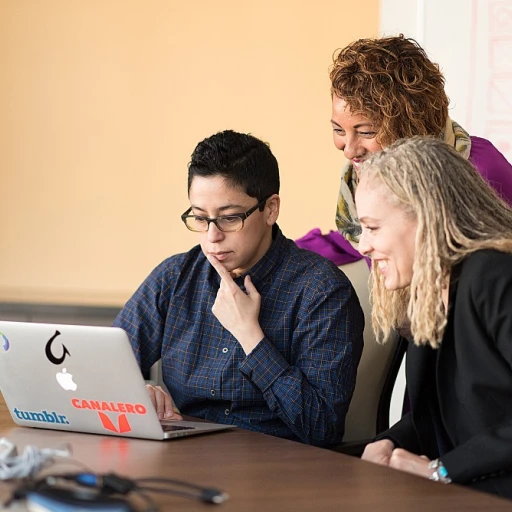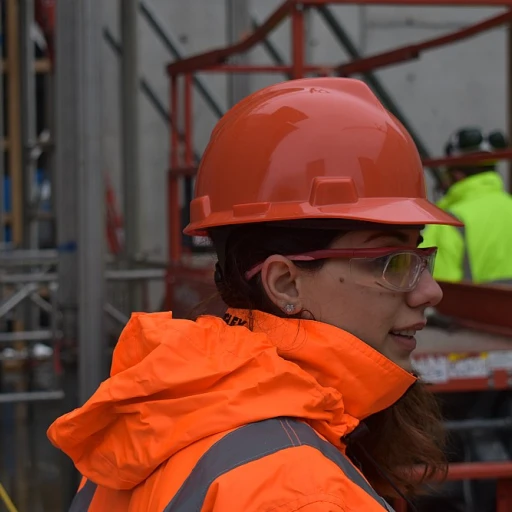Understanding Ageism: A Workplace Challenge
Ageism: The Unseen Barrier in Employment
Ageism in the workplace often goes unnoticed, yet it's just as pervasive and damaging as any other form of discrimination. In many cases, age becomes a silent reason for bias in employment decisions, from job assignments to promotions. This undesirable trend affects both older workers who may face assumptions of being out of touch or less adaptable and younger workers who might be perceived as inexperienced or less competent. The age-based stereotyping can subtly permeate employee feedback, compounding its impact.
In a professional environment, diverse employees ages should be seen as a strength rather than a liability. Those with substantial experience bring valuable insights, while younger employees often introduce fresh perspectives and innovative ideas. However, ageism can distort this balance, leading to discriminatory practices that overlook the value each age group brings to the table.
The modern workplace faces the challenge of bridging the gap between generations, fostering an inclusive culture where age discrimination is recognized and addressed. Acknowledging ageism in employment is the first step toward accountability, as no age group should feel marginalized based on age. To effectively tackle this, companies must educate employers and employees alike about recognizing and combating ageism.
Understanding how ageism manifests in employee feedback is a critical component of creating a more inclusive workplace culture. Recognizing these subtle signs can help organizations develop tailored strategies to combat discrimination and ensure a respectful, fair environment for all workers. If you're interested in learning more about navigating different work dynamics, check out this exploration of
understanding the dynamics of split shifting in the workplace.
Subtle Signs of Ageism in Employee Feedback
Unveiling Subtle Instances of Ageism
Age discrimination in the workplace isn't always glaringly obvious. It isn't only about remarks or actions pointing directly at one age group over another. Instead, it's often much subtler, manifesting in ways that might not immediately be recognized as discriminatory.
One example of subtle ageism comes from the way employee feedback is given. Older employees might find it challenging to receive constructive criticism from younger supervisors, especially when the language used suggests age-related bias, such as phrases like "not keeping up with the times." Such instances might seem innocuous but can contribute significantly to an environment where age-based discrimination thrives.
Another example is when older workers are perceived as less adaptable to new technologies, mirroring societal stereotypes rather than focusing on the individual's capabilities or potential. This perception can be reflected in their performance reviews or during evaluation discussions, subtly influencing their progression within the company.
In many cases, older employees might be sidelined in critical projects or decision-making processes under the guise of "fresh perspectives," pushing the narrative that younger employees inherently possess more innovative ideas. This form of workplace bias doesn't just affect the older workers directly involved; it impacts the morale and productivity of those around them, who may fear a similar fate as they continue to age.
To understand these dynamics and how they actually operate, examining the
dynamics of split-shifting in the workplace can provide deeper insights, especially when it comes to managing different employee ages and experiences more effectively. Recognizing these subtle signs is crucial in addressing and mitigating the effects of ageism within a company, fostering a more inclusive and equitable workplace for all employees, irrespective of age.
Impact of Ageism on Employee Morale and Productivity
Consequences of Ageism on Workforce Dynamics
Ageism, or discrimination based on age, can subtly seep into workplace environments, manifesting in ways that can profoundly affect both the morale and productivity of employees. When age discrimination occurs, older employees often encounter obstacles that hinder their ability to thrive, contributing to a negative work atmosphere.
For example, ageist attitudes might lead to assumptions that older workers are less adaptable to new technologies or less able to contribute innovative ideas, despite their wealth of experience. When older employees consistently face these stereotypes, it erodes their confidence and diminishes their motivation, making it challenging for them to stay engaged at work.
A workplace culture tainted by ageism may also pit younger workers against their older counterparts, fostering a sense of division and competition rather than collaboration. This dynamic can further inhibit productivity, as teamwork becomes strained and communication breaks down.
Moreover, when older employees feel undervalued or sidelined, they may become disenchanted, leading to higher turnover rates or early retirement, causing a loss of valuable talent and institutional knowledge. This attrition can be costly for employers, who must then invest additional resources in hiring and training new talent.
An essential step towards alleviating these issues is through comprehensive understanding of employee feedback. Such feedback can reveal unnoticed patterns of age-based discrimination and help identify areas that require immediate attention. Employers can learn valuable lessons from real-world situations and adjust their strategies to create a more inclusive atmosphere that respects and celebrates diversity in age groups.
Realizing the detrimental impact of age discrimination is crucial for fostering a harmonious and productive environment. It's essential for employers to actively engage in conversations about ageism and implement policies that encourage a culture of respect and inclusivity for all age groups.
Introducing thoughtful measures, such as mentoring programs where older employees can share their knowledge with younger ones, can encourage mutual respect and understanding across generations. Caution should be exercised by employers to genuinely listen and act on their employee's feedback, allowing for positive changes that enhance both work dynamics and employee morale.
For ideas on how to translate employee feedback into tangible improvements, reviewing effective strategies to combat ageism might provide insightful examples of creating a harmonious workplace. You can find more information about
enhancing employee feedback as part of comprehensive anti-ageism measures.
Real-Life Examples of Ageism in the Workplace
Unmasking Real-Life Incidents of Ageism
In order to fully grasp the extent of ageism in the workplace, it’s important to look at some real-world examples that highlight how pervasive this form of discrimination can be. These scenarios shed light on the nuanced and often covert ways ageism can manifest, affecting employees of all age groups.
One common example is when older employees find themselves passed over for promotions in favor of younger workers. This isn't always due to a lack of competence or experience; rather, it stems from a bias that younger employees are more capable of handling new technologies or adapting to workplace changes. This unfair bias diminishes the value of the older workers' extensive experience and insight, contributing to discrimination.
In some cases, older workers may face undue pressure to retire, despite their desire and capability to continue working. Employers may imply that it's "time to make way" for younger professionals, thus disregarding the rights of these employees to remain in their positions as long as they can perform their duties. This form of discrimination based on age not only affects the older employees themselves but also sets a troubling precedent for the workplace culture as a whole.
On the flip side, younger employees can also encounter age discrimination. For instance, they might be excluded from decision-making processes under the assumption that they lack sufficient experience or maturity. This type of discrimination in employment stifles diversity of thought and prevents younger workers from contributing fresh, innovative ideas.
These examples of ageism demonstrate that such discrimination can happen at any stage of employment and can involve workers of various ages. It’s crucial to recognize these instances to foster a more equitable work environment where employees, regardless of age, have equal opportunities to grow and succeed.
Strategies to Combat Ageism in Employee Feedback
Dismantling Age-Based Assumptions
Addressing age-based discrimination in employee feedback requires a well-rounded approach that targets both systemic biases and individual perceptions. Older workers often face assumptions about technological adaptiveness or health, while younger employees might be unfairly seen as inexperienced or uninterested in long-term results.
Anonymous Surveys for Genuine Insights
One effective strategy is the implementation of anonymous surveys. These can unveil subtle age-based biases in feedback, allowing employers to gain a clearer picture without the filter of social pressures. Such surveys may reveal patterns of discriminatory comments or highlight biases that could affect the morale of older employees, as well as younger workers.
Enhancing Empathy Through Training
Investing in empathy training ensures that discourse around discrimination age issues is open and constructive. Training sessions can bring awareness to common assumptions and create spaces for dialogue between different age groups. By encouraging understanding among employees of all ages, workplaces can mitigate the impacts of ageism.
Using Regular Feedback Loops
Regular feedback loops are crucial for continuous improvement in combating examples ageism in the workplace. Employers should create feedback mechanisms that encourage open dialogue about age-related concerns, facilitating transparency and ensuring that changes are responsive to employee needs.
Leveraging Employment Law for a Fair Work Environment
Understanding and adhering to employment law concerning discrimination workplace practices is essential. Employers need to be informed about legal obligations to protect against discrimination employment issues, providing all employees, regardless of age, with equal opportunities for growth and development.
By actively implementing these strategies, employers and leaders can begin to combat ageism in the workplace, fostering a culture that respects and values employees of all ages.
Creating an Inclusive Workplace Culture
Fostering Diversity and Acceptance in the Workplace
Creating an inclusive workplace culture is essential in combating ageism and ensuring that age discrimination does not hinder the potential of both older and younger employees. Here are some strategies that employers can implement to foster a more accepting environment:
- Emphasize Diversity Training: Employers should invest in age diversity training programs that educate employees about the benefits of diverse age groups in the workplace. These programs can help dispel myths about older workers and promote understanding among different ages.
- Promote Experience Sharing: Encourage the sharing of experiences across age groups. For instance, mentoring programs can bridge the gap between younger and older employees, enhancing mutual respect and learning opportunities.
- Age-Inclusive Policies: Employment law policies should be reviewed and updated to ensure they support and do not discriminate against any age group. This includes re-evaluating retirement age norms and promoting age-based inclusion in hiring practices.
- Communication and Feedback Mechanisms: Employers should establish open communication channels for employees to report instances of age discrimination. Regular feedback sessions can help identify subtle signs of ageism that might otherwise go unnoticed.
- Commitment from Leadership: Leadership commitment is crucial in promoting an inclusive culture. By leading by example and visibly supporting efforts to reduce age discrimination, leaders can set a tone of acceptance throughout the organization.
Ultimately, employers need to recognize that an inclusive culture is not only beneficial for older employees but also for the overall productivity and morale of the workplace. By fostering a culture of acceptance and diversity, organizations can unlock the full potential of their workforce and mitigate the impact of ageism on their employees and operations.













